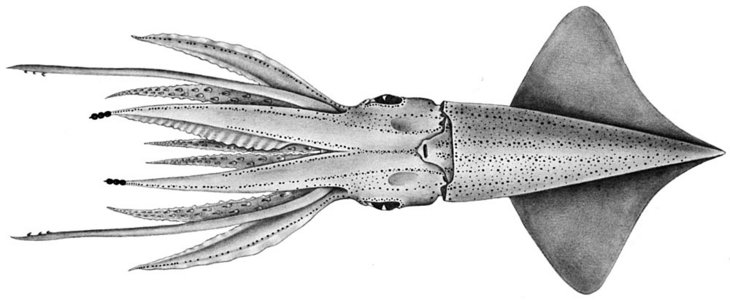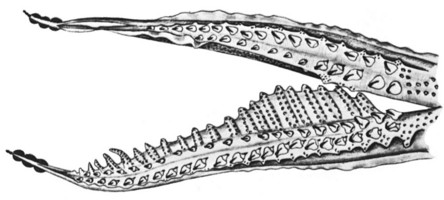Abraliopsis falco
Kotaro TsuchiyaIntroduction
A. falco is characterized by having stripes of integumental photophore on the mantle and unusual arm modification of the male.
Characteristics
- Tentacle clubs
- Two rows of different-sized hooks on manus.
- Carpal flap absent; aboral keel short, narrow.
- Arms
- Arms IV relatively long; ALI IV = 55-79.
- Arms I-III with 15 to 34 hooks and distal suckers.
- Female with 21-26 hooks on arm IV; male with 26-31 hooks on hectocotylized arm (right arm IV) and 40-45 hooks on modified left arm IV.
- Hectocotylus and male sexual dimorphism
- Hectocotylus with two subequal-sized offset flaps.
- Modified portion of hectocotylus without armature.
- Protective membrane and its spatulate trabeculae well developed on left arm IV, web-like; with minute conical papillae on trabeculae.
- Oral surface of arms I-III ornamented with small numerous conical papillae.
- Integumental Photophores
- Ventral mantle with six narrow longitudinal stripes of large integumental organs and and scattered intermediate small organs with a distinct wide mid-ventral photophore-less strip.
- Ventral head with three rows of narrow, longitudinal stripes and some intermediate scattered organs.
- Rows of organs along ventral side of arm III and dorsal side of arm IV is interrupted.
Distribution
Geographical Distribution
This species is distributed in the tropical East Pacific from 30° N (Young, 1972) and southward to about 20° S (Okutani, 1974).
References
Okutani, T. 1974. Epipelagic decapod cephalopods collected by midwater tows during the EASTROPAC Expedition, 1967-1968 (systematic part). Bull. Tokai Reg. Fish. Res. Lab., 80:29-118.
Young, R.E. 1972. The systematics and areal distribution of pelagic cephalopods from the sea off southern California. Smiths. Contr. Zool., 97:1-159.
About This Page

Tokyo University of Fisheries, Tokyo, Japan
Page copyright © 2009
All Rights Reserved.
- Content changed 01 August 2009
Citing this page:
Tsuchiya, Kotaro. 2009. Abraliopsis falco . Version 01 August 2009 (under construction). http://tolweb.org/Abraliopsis_falco/19685/2009.08.01 in The Tree of Life Web Project, http://tolweb.org/











 Go to quick links
Go to quick search
Go to navigation for this section of the ToL site
Go to detailed links for the ToL site
Go to quick links
Go to quick search
Go to navigation for this section of the ToL site
Go to detailed links for the ToL site